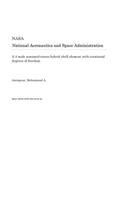
A 4-Node Assumed-Stress Hybrid Shell Element with Rotational Degrees of Freedom
Series:
An assumed-stress hybrid/mixed 4-node quadrilateral shell element is introduced that alleviates most of the deficiencies associated with such elements. The formulation of the element is based on the assumed-stress hybrid/mixed method using the Hellinger-Reissner variational principle. The membrane part of the element has 12 degrees of freedom including rotational or drilling degrees of freedom at
NaN
VOLUME
English
Paperback

An assumed-stress hybrid/mixed 4-node quadrilateral shell element is introduced that alleviates most of the deficiencies associated with such elements. The formulation of the element is based on the assumed-stress hybrid/mixed method using the Hellinger-Reissner variational principle. The membrane part of the element has 12 degrees of freedom including rotational or drilling degrees of freedom at the nodes. The bending part of the element also has 12 degrees of freedom. The bending part of the element uses the Reissner-Mindlin plate theory which takes into account the transverse shear contributions. The element formulation is derived from an 8-node isoparametric element. This process is accomplished by assuming quadratic variations for both in-plane and out-of-plane displacement fields and linear variations for both in-plane and out-of-plane rotation fields along the edges of the element. In addition, the degrees of freedom at midside nodes are approximated in terms of the degrees of freedom at corner nodes. During this process the rotational degrees of freedom at the corner nodes enter into the formulation of the element. The stress field are expressed in the element natural-coordinate system such that the element remains invariant with respect to node numbering. Aminpour, Mohammad A. Unspecified Center NAS1-18599; RTOP 505-63-01-10...
Price Comparison [India]
In This Series
Bestseller Manga
Trending NEWS




















